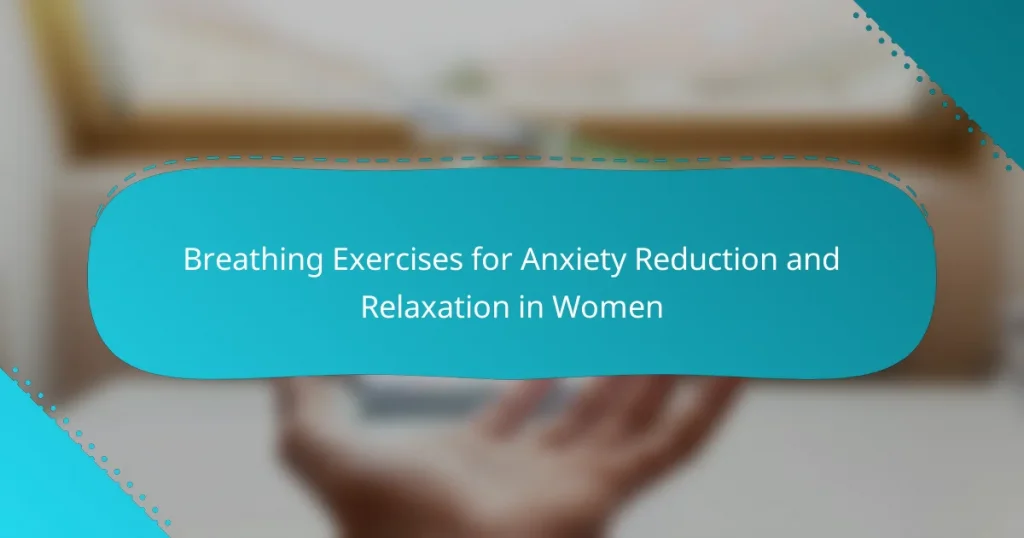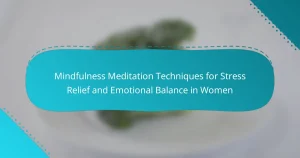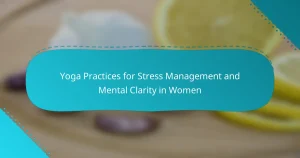Breathing exercises effectively reduce anxiety and promote relaxation in women. These techniques enhance emotional balance, improve mindfulness, and lower stress levels. Key methods include deep diaphragmatic breathing, box breathing, and alternate nostril breathing. Personalization and environmental factors can further enhance their effectiveness in daily life.
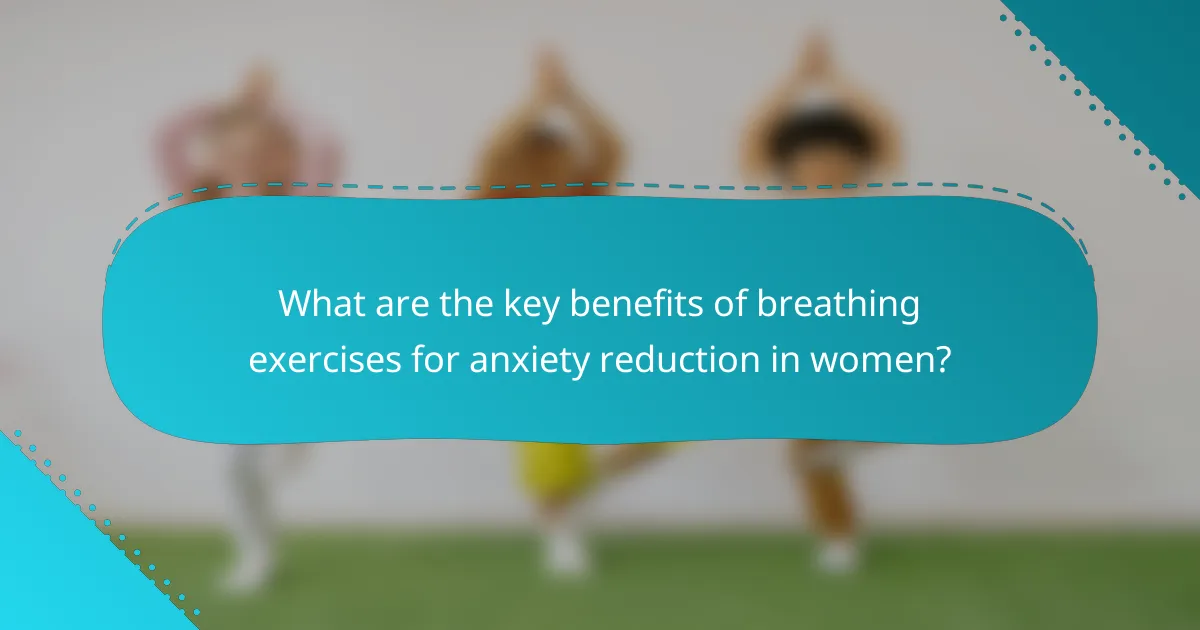
What are the key benefits of breathing exercises for anxiety reduction in women?
Breathing exercises significantly reduce anxiety in women by promoting relaxation and emotional balance. These techniques enhance oxygen flow, lower heart rate, and activate the parasympathetic nervous system, leading to decreased stress levels. Studies show that regular practice can improve overall mental health and resilience. Unique benefits include increased mindfulness and enhanced emotional regulation, which are essential for managing anxiety.
How do breathing exercises promote relaxation?
Breathing exercises effectively promote relaxation by activating the body’s parasympathetic nervous system. This response reduces stress hormones and lowers heart rate, fostering a sense of calm. Research indicates that deep breathing can lower anxiety levels by up to 60%. Techniques such as diaphragmatic breathing enhance oxygen flow, which further alleviates tension. Regular practice of these exercises can lead to long-term improvements in emotional regulation and overall well-being.
What physiological changes occur during breathing exercises?
Breathing exercises induce several physiological changes that promote relaxation and reduce anxiety in women. These changes include decreased heart rate, lower blood pressure, and enhanced oxygenation of the blood. As a result, the body enters a state of calmness, which can alleviate stress and tension. Additionally, engaging in these exercises can stimulate the vagus nerve, leading to improved emotional regulation and a sense of well-being.
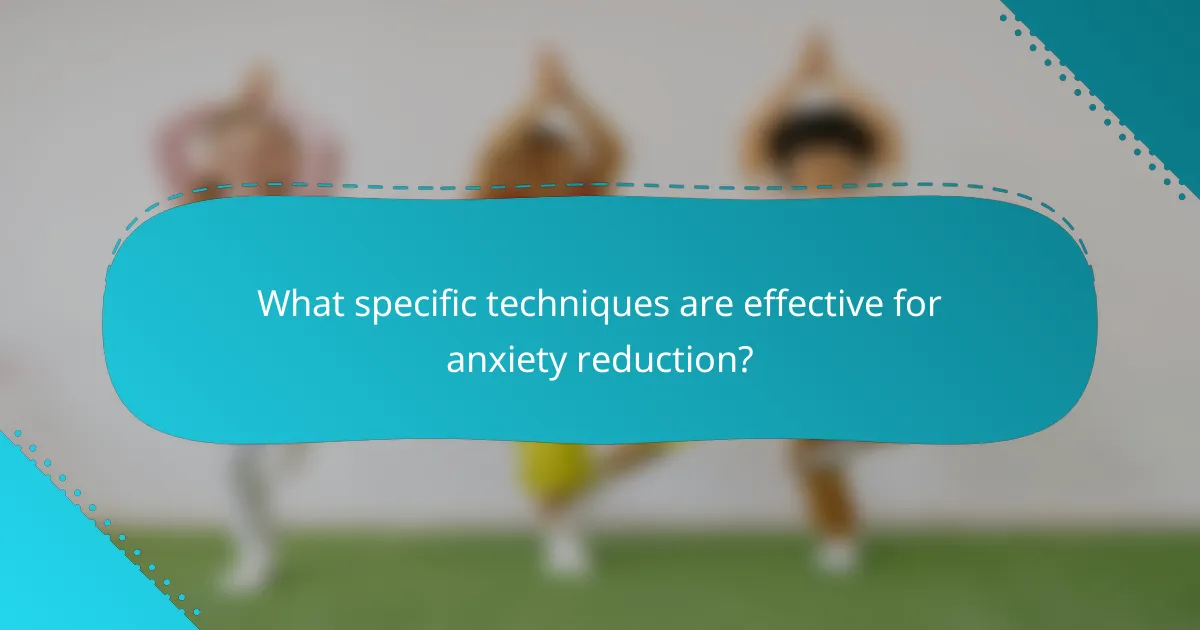
What specific techniques are effective for anxiety reduction?
Breathing exercises are effective techniques for anxiety reduction and relaxation in women. These exercises promote mindfulness, reduce stress, and enhance emotional well-being.
Deep diaphragmatic breathing helps activate the body’s relaxation response. This technique involves inhaling deeply through the nose, allowing the abdomen to expand, and exhaling slowly through the mouth. Research shows that this method can lower heart rate and cortisol levels.
Box breathing is another beneficial technique. This method consists of four equal parts: inhale for four counts, hold for four counts, exhale for four counts, and hold again for four counts. This structured approach aids in calming the mind and reducing anxiety.
Alternate nostril breathing is a unique practice that balances the body’s energy. By inhaling through one nostril while closing the other, then switching, this technique promotes a sense of tranquility and balance.
Progressive muscle relaxation complements breathing exercises. This technique involves tensing and relaxing different muscle groups while focusing on breath, enhancing the overall relaxation experience.
How does diaphragmatic breathing help alleviate anxiety?
Diaphragmatic breathing effectively reduces anxiety by promoting relaxation and lowering heart rate. This technique engages the diaphragm, allowing for deeper breaths that enhance oxygen flow. As a result, it activates the parasympathetic nervous system, which counteracts stress responses. Research shows that individuals practicing diaphragmatic breathing report significant reductions in anxiety levels. By focusing on breath control, women can cultivate a sense of calm and improve emotional regulation.
What are the steps for practicing diaphragmatic breathing?
Diaphragmatic breathing involves a few simple steps to effectively reduce anxiety and promote relaxation.
1. Find a comfortable position, either sitting or lying down.
2. Place one hand on your chest and the other on your abdomen.
3. Inhale deeply through your nose, allowing your abdomen to rise while keeping your chest still.
4. Exhale slowly through your mouth, feeling your abdomen fall.
5. Repeat this process for several minutes, focusing on your breath and maintaining a steady rhythm.
This technique enhances lung capacity and promotes calmness, making it beneficial for women experiencing anxiety.
What role does box breathing play in managing anxiety?
Box breathing effectively manages anxiety by promoting relaxation and mindfulness. This technique involves inhaling for four counts, holding for four counts, exhaling for four counts, and holding again for four counts. Research shows that this method can reduce stress hormones and enhance emotional regulation. Additionally, box breathing can improve focus and clarity, making it beneficial for women experiencing anxiety. Regular practice may lead to long-term improvements in mental well-being.
How can one implement box breathing in daily routines?
To implement box breathing in daily routines, set aside five minutes in a quiet space. Inhale deeply through the nose for four counts, hold for four counts, exhale through the mouth for four counts, and pause for four counts before repeating. This technique fosters relaxation and reduces anxiety. Consistency enhances its effectiveness, making it beneficial for women’s mental well-being.
What is the 4-7-8 breathing technique and its effectiveness?
The 4-7-8 breathing technique is an effective method for anxiety reduction and relaxation. It involves inhaling for four seconds, holding for seven seconds, and exhaling for eight seconds. This technique promotes calmness and reduces stress levels, making it particularly beneficial for women experiencing anxiety. Studies indicate that regular practice can enhance overall emotional well-being and improve sleep quality. By focusing on breath control, it helps activate the body’s relaxation response, which can lead to lower heart rates and reduced feelings of tension.
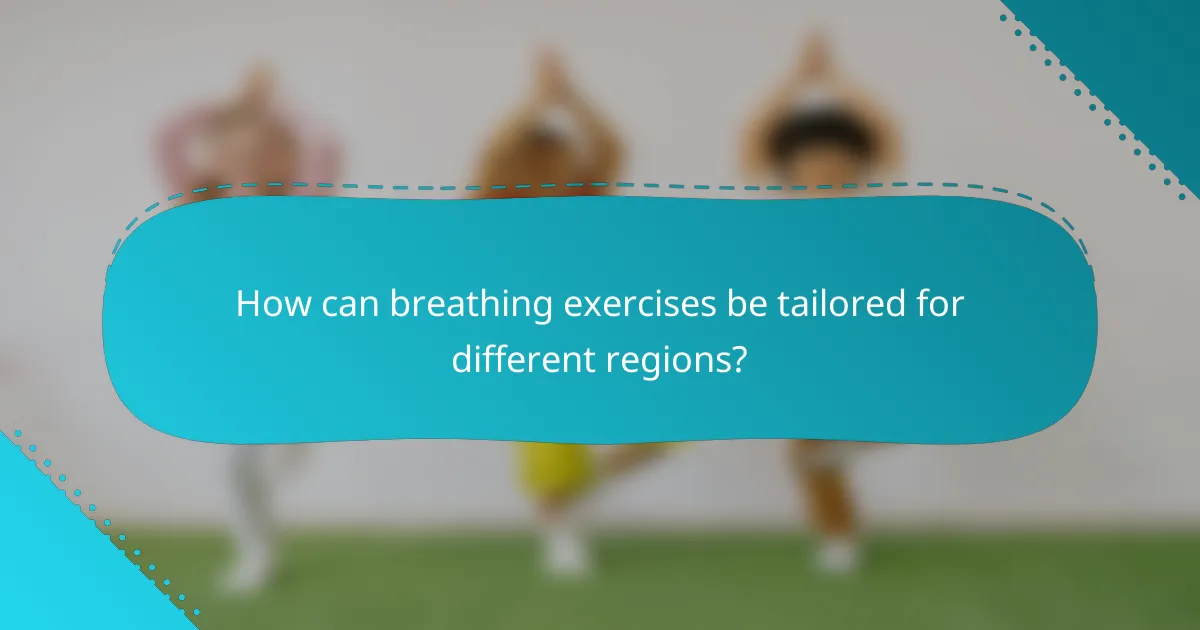
How can breathing exercises be tailored for different regions?
Breathing exercises can be customized for different regions by considering cultural practices and physical environments. For example, in coastal areas, exercises may focus on deep diaphragmatic breathing to enhance relaxation and connection with nature. In urban settings, techniques might emphasize quick stress relief due to fast-paced lifestyles. Women can benefit from these tailored approaches, as they often face unique stressors. Incorporating local elements, such as sounds or scents, can further enhance the effectiveness of breathing exercises.
What cultural adaptations exist for breathing exercises in various locales?
Cultural adaptations for breathing exercises in various locales emphasize local traditions and practices. For instance, in India, pranayama incorporates spiritual elements, while in Japan, Zen breathing techniques focus on mindfulness. In Western cultures, structured programs often emphasize scientific approaches to anxiety reduction. Unique attributes include the integration of local music or nature sounds in practices, enhancing relaxation. These adaptations reflect diverse cultural values and beliefs, enriching the overall experience of breathing exercises.
How do societal perceptions influence the practice of breathing exercises?
Societal perceptions significantly shape the practice of breathing exercises among women for anxiety reduction and relaxation. Cultural attitudes towards mental health often determine the acceptance and frequency of these practices. In societies where mental wellness is prioritized, women are more likely to embrace breathing exercises as effective coping mechanisms. Conversely, stigma around anxiety may discourage some women from engaging in these practices. Social support networks can enhance the visibility of breathing exercises, making them more accessible and normalized. As a result, positive societal views can lead to increased participation in these beneficial practices.
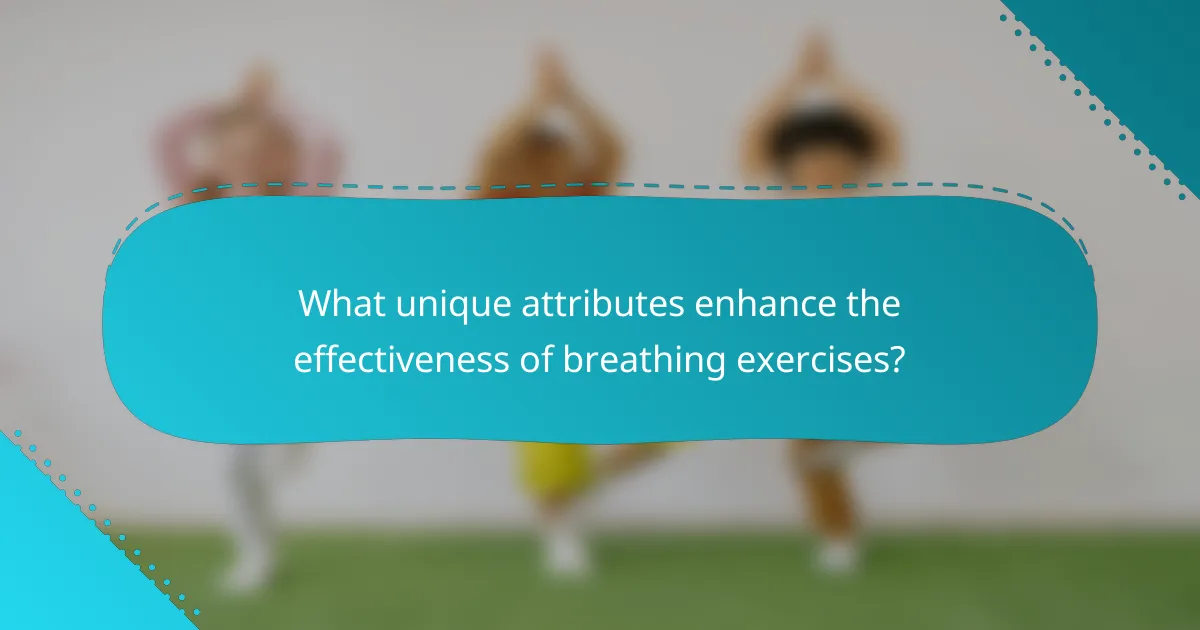
What unique attributes enhance the effectiveness of breathing exercises?
Breathing exercises for anxiety reduction and relaxation in women are enhanced by unique attributes such as personalization, breath control techniques, and environmental factors. Personalization allows exercises to be tailored to individual needs, increasing their effectiveness. Breath control techniques, like diaphragmatic breathing, improve oxygen flow and reduce stress. Environmental factors, such as a calming space, further enhance relaxation and focus during practice. These unique attributes collectively contribute to the overall effectiveness of breathing exercises in managing anxiety.
How does individual variability affect the outcomes of breathing exercises?
Individual variability significantly influences the effectiveness of breathing exercises for anxiety reduction and relaxation in women. Factors like physical health, psychological state, and personal preferences can lead to diverse outcomes. For example, women with higher stress levels may experience greater relief through these exercises, while those with specific respiratory conditions might face limitations. Additionally, the unique attribute of each woman’s response to different techniques, such as diaphragmatic versus paced breathing, can determine their success. Understanding these variabilities allows for tailored approaches, enhancing the overall impact of breathing exercises on anxiety management.
What are the rare techniques that can amplify relaxation effects?
Certain rare techniques can enhance relaxation through breathing exercises for anxiety reduction in women. One such technique is the “4-7-8” breathing method, which involves inhaling for four seconds, holding for seven seconds, and exhaling for eight seconds. This method has been shown to lower heart rate and promote calmness. Another unique approach is “coherent breathing,” which encourages a steady rhythm of five breaths per minute, fostering a deep sense of relaxation. Additionally, “bhramari” or humming bee breath, which incorporates sound while exhaling, can amplify relaxation by engaging the vagus nerve, promoting a sense of tranquility. These rare techniques can effectively complement traditional breathing exercises, enhancing overall relaxation outcomes.
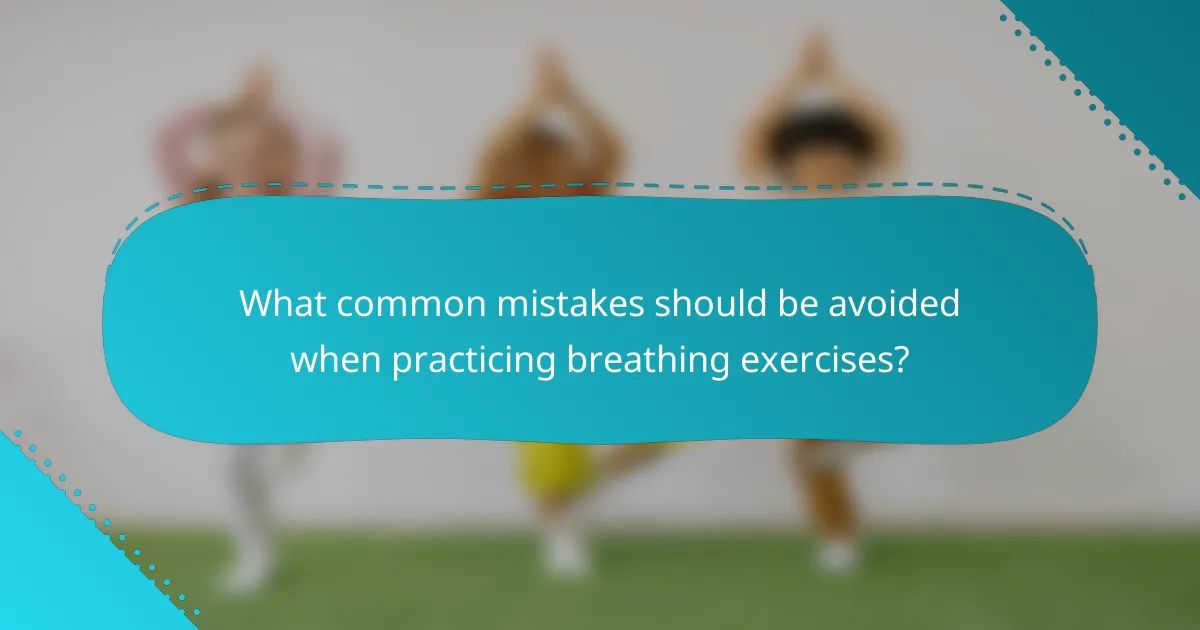
What common mistakes should be avoided when practicing breathing exercises?
Avoiding common mistakes in breathing exercises can enhance their effectiveness for anxiety reduction and relaxation. Key errors include improper posture, shallow breathing, and rushing through techniques. Maintaining an upright posture ensures optimal lung capacity. Shallow breathing limits oxygen intake, while rushing can lead to increased anxiety rather than relaxation. Additionally, neglecting to focus on the breath can diminish the calming benefits. By being mindful of these aspects, women can maximize the positive effects of breathing exercises.
How can improper technique hinder anxiety reduction?
Improper technique can significantly hinder anxiety reduction by causing physical tension and ineffective breathing patterns. Incorrect posture may restrict airflow, leading to shallow breaths that increase anxiety instead of alleviating it. Additionally, focusing on the wrong aspects of breathing exercises can create frustration, diminishing their calming effects. Consistent practice of proper techniques is essential for maximizing benefits.
What tips can enhance the effectiveness of breathing exercises?
To enhance the effectiveness of breathing exercises for anxiety reduction in women, focus on consistency, environment, and technique. Practicing regularly in a quiet space promotes relaxation. Use diaphragmatic breathing to maximize oxygen intake, which can lower stress levels. Incorporate visualization techniques, imagining peaceful scenes, to deepen the relaxation response. Finally, combine breathing exercises with mindfulness to increase awareness of the present moment, which can further alleviate anxiety.
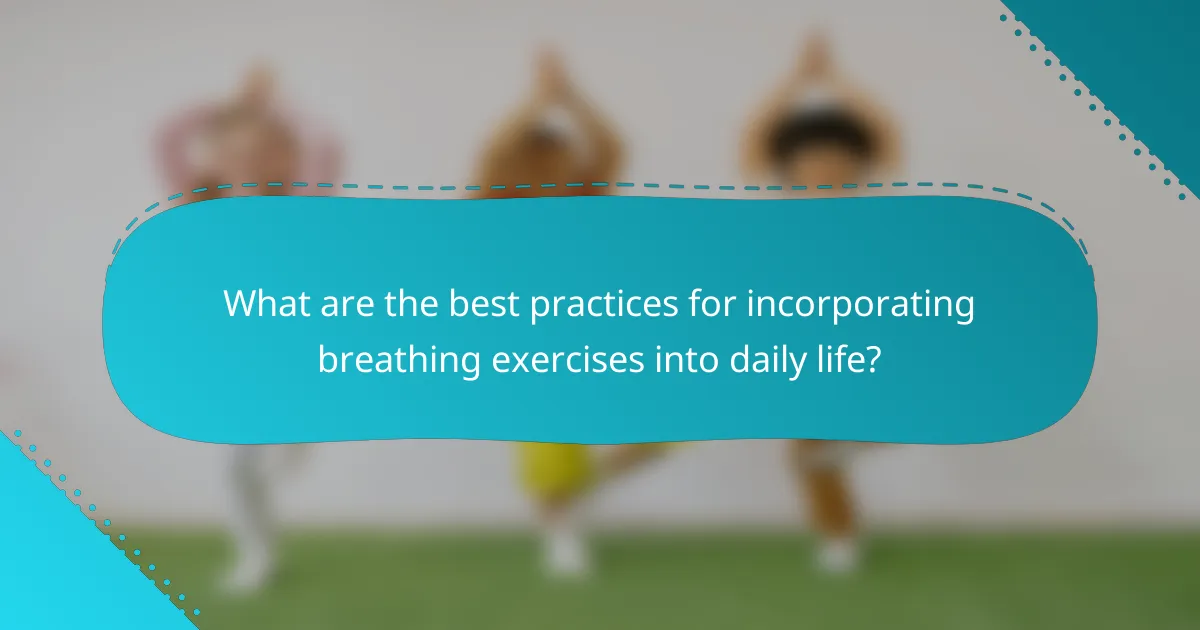
What are the best practices for incorporating breathing exercises into daily life?
Incorporating breathing exercises into daily life can significantly reduce anxiety and promote relaxation. Start by setting aside a few minutes each day, ideally in a quiet space. Use techniques like deep diaphragmatic breathing, where you inhale deeply through the nose, allowing the abdomen to expand, then exhale slowly through the mouth. Integrate these exercises during routine activities, such as while commuting or during breaks at work. Consistency is key; aim for at least five minutes of practice, gradually increasing duration as comfort grows. Consider pairing exercises with mindfulness or meditation to enhance their effectiveness.
How can one create a consistent breathing exercise routine?
To create a consistent breathing exercise routine, schedule sessions at the same time daily. Start with five minutes, focusing on deep inhalations and slow exhalations. Gradually increase duration as comfort grows. Utilize guided audio or apps for structure. Track progress to maintain motivation, noting improvements in anxiety levels and relaxation.
What role does environment play in the effectiveness of breathing exercises?
The environment significantly influences the effectiveness of breathing exercises for anxiety reduction and relaxation in women. A calm and quiet space enhances focus and reduces distractions, making it easier to achieve deeper relaxation. Natural settings, such as parks or gardens, may provide additional benefits by promoting a sense of peace and connection to nature. Studies show that environments with soothing colors and sounds can further enhance the calming effects of these exercises.
